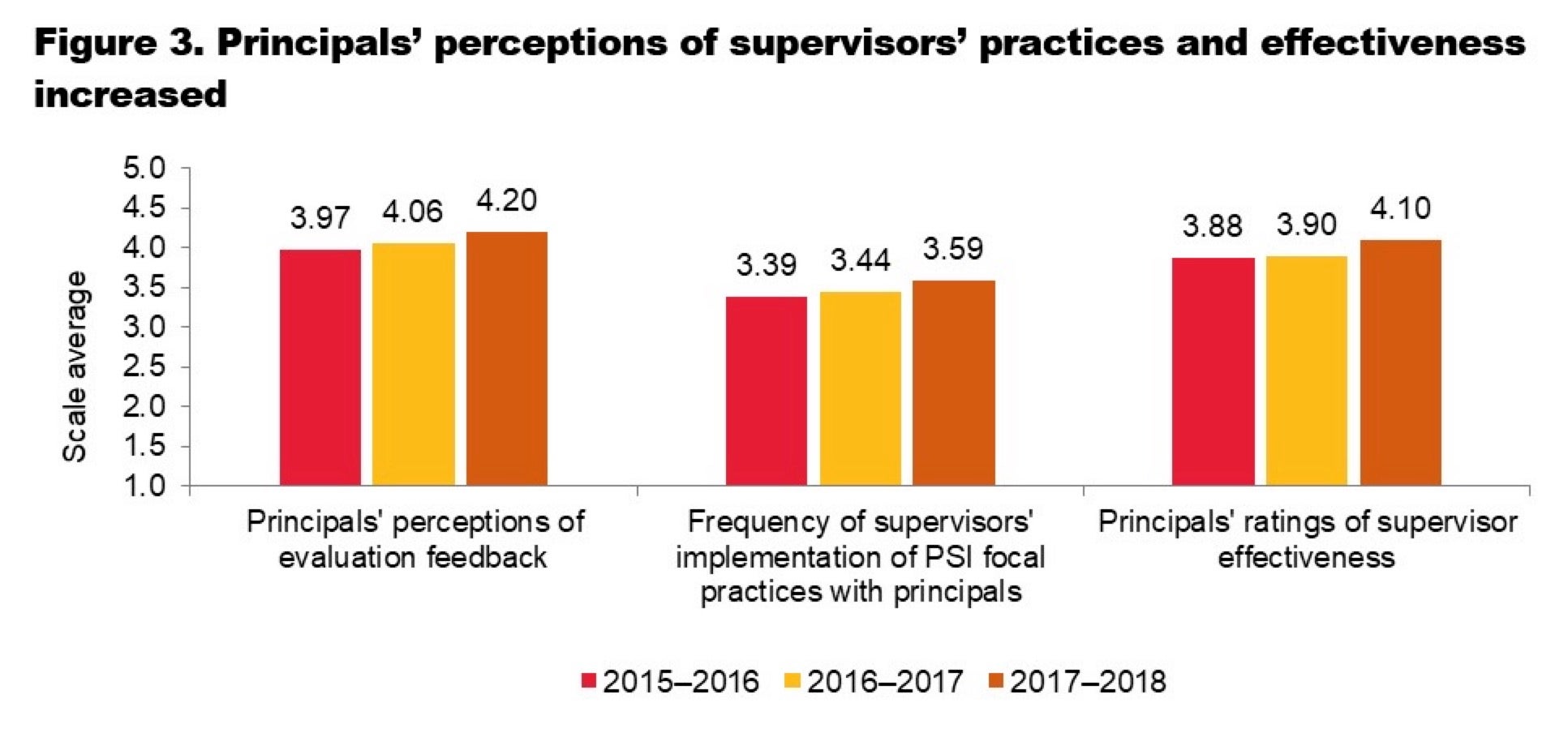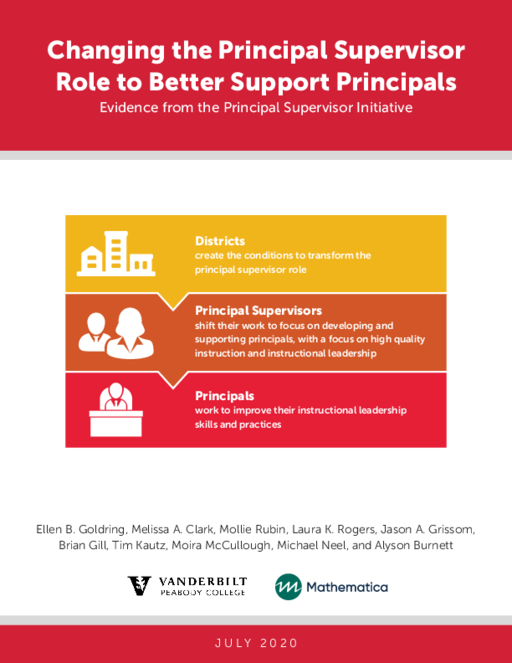Breadcrumb
- Wallace
- Reports
- Changing The Principal Superviso...
Changing the Principal Supervisor Role to Better Support Principals

- Author(s)
- Ellen Goldring, Melissa A. Clark, Mollie Rubin, Laura K. Rogers, Jason A. Grissom, Brian Gill, Tim Kautz, Moira McCullough, Michael Neel, and Alyson Burnett
- Publisher(s)
- Vanderbilt University and Mathematica Policy Research
Summary
How we did this
The report is based on analyses of data from site visits, interviews, surveys, and teacher ratings of principal performance.
The principal supervisor role has traditionally focused on administration, operations, and compliance. The need to remake that role has gained attention in recent years. Principals need more support from their supervisors to perform an increasingly complex job.
In 2014, six large school districts around the country launched an effort to redesign the principal supervisor position. They refocused the role on supporting principals to improve classroom instruction. The Wallace Foundation funded the four-year, $24-million Principal Supervisor Initiative.
Initiative Results
This report looks at the final year of the initiative and its impact. It concludes that:
- Districts changed the principal supervisor job. The redesigned role centered on helping principals promote effective teaching and learning in their schools.
- Principals’ ratings of their supervisors’ effectiveness rose during the initiative. The ratings increased from 3.88 to 4.10 on a scale of 1 to 5. This is a statistically significant increase.
- Principals reported greater frequency of supervisor practices to develop school leadership. This included helping principals with data analysis. It also included working with them to assess teacher effectiveness.
- The initiative did not improve how teachers viewed the performance of their principals. The researchers suggested a number of possible reasons why. One was that the timeframe of the study was too short to detect any change.
The districts took a number of steps to alter the job, including:
- Reducing the number of principals whom supervisors oversaw from an average of 17 to 13
- Training supervisors to recognize high-quality instruction
- Adopting coaching models with steps for giving feedback to principals
- Changing aspects of district central offices to better support supervisors.
Both supervisors and principals gave higher ratings to the quality of support they received from district headquarters as a result. One example is the proportion of principals agreeing that their central office was organized to support them. The percentage of principals who agreed rose from 41 percent to 57 percent by the end of the initiative.

Probably the biggest accomplishment is an overwhelming sentiment that principals are far more ... confident in their abilities to lead, support, and monitor instructional practices as a result of the support and training and PD of their principal supervisor.
— A district leader
Challenges to Changing the Principal Supervisor Role
The data also showed that 43 percent of principals remained less than fully satisfied with their central office. This may be because some parts of the effort presented challenges. These included:
- Some central office staff members resisted needed changes such as becoming more responsive to schools.
- Budget shortfalls and changing leadership in some districts made it hard to sustain the initiative.
- Some principal supervisors found the new role more demanding than their old one and resisted adopting new practices.
The report ends with a series of lessons for districts considering redesigning the principal supervisor role. One is the value of investing in rigorous selection and training of supervisors. Another is the need to build buy-in for the new role from principals, central office staffers, and school board members.
The six districts participating in the Principal Supervisor Initiative were:
- Baltimore City Public Schools
- Broward County Public Schools, Fla.
- Cleveland Metropolitan School District
- Des Moines Public Schools
- Long Beach Unified School District, Calif.
- Minneapolis Public Schools
Key Takeaways
- Six large school districts successfully redesigned the principal supervisor role to focus on supporting principals as instructional leaders.
- Principals’ ratings of their supervisors’ effectiveness rose during the initiative. The increase was 3.88 to 4.10 on a scale of 1-to-5. This is a statistically significant increase.
- Principals reported greater frequency of supervisor practices to develop school leadership. This included helping principals with data analysis. It also included working with them to assess teacher effectiveness.
- The districts took a number of steps to alter the job. This included reducing the number of principals their supervisors oversaw from an average of 17 to 13. Supervisors were trained to recognize high-quality instruction. They adopted specific coaching models. They also changed practices at central offices to better support principal supervisors.
- There were obstacles to successfully changing the principal supervisor role. These included budget shortfalls and district leadership turnover. These factors made sustaining change more difficult. Some central offices and principal supervisors resisted changes to their roles.
Visualizations
Principal Perceptions of Supervisors

Materials & Downloads
What We Don't Know
- Why didn’t teachers’ perceptions of principal performance improve during the initiative?
- What is the best way to use the principal supervisor role to support principal performance?
- Can redesigning the principal supervisor role be shown to improve principal retention, teacher retention, teacher satisfaction, and student performance?

